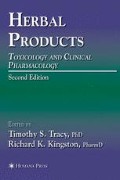Abstract
Although feverfew has been demonstrated to provide therapeutic benefit to isolated patient groups and at varying dosage levels, its clinical effectiveness has not been consistently reported. A variety of caveats associated with study design, identification or concentration of appropriate substance, or duration of evaluation from previous clinical studies complicate the assessment of the overall benefit of the herb. Despite inconsistent reports of effectiveness, the favorable safety profile and low risk of use suggest a positive risk benefit for patients looking for migraine prophylaxis treatment alternatives.
Access this chapter
Tax calculation will be finalised at checkout
Purchases are for personal use only
Preview
Unable to display preview. Download preview PDF.
References
Anonymous, ed. Feverfew. In:The Lawrence Review of Natural Products. St. Louis: Facts and Comparisons, 1994.
Tyler VE, ed. The Honest Herbal, 3rd edition. Binghamton: Pharmaceutical Products Press, 1993.
Knight DW. Feverfew: chemistry and biological activity. Nat Prod Rep 1995;12:271–276.
United States Pharmacopeial Convention (USP). Feverfew. Botanical Monograph Series. Rockville: United States Pharmacopeial Convention, 1998.
Heptinstall S, Awang DVC, Dawson BA, Kindack D, Knight DW, May J. Parthenolide content and bioactivity of feverfew (Tanacetum parthenium [L.] schultz-Bip.). Estimation of commercial and authenticated feverfew products. J Pharm Pharmacol 1992;44:391–395.
Tyler VE, ed. Herbs of Choice: the Therapeutic Use of Phytomedicinals. Binghamton: Pharmaceuticals Products Press, 1994.
Johnson ES, Kadam NP, Hylands DM, Hylands PJ. Efficacy of feverfew as prophylactic treatment of migraine. Br Med J 1985;291:569–573.
Palevitch D, Earon G, Carasso R. Feverfew (Tanacetum parthenium) as a prophylactic treatment for migraine: a double-blind placebo-controlled study. Phytother Res 1997; 11:508–511.
Murphy JJ, Heptinstall S, Mitchell JRA. Randomized, double-blind placebo-controlled trial of feverfew in migraine prevention. Lancet 1988;2:189–192.
Groenewegen WA, Heptinstall S. Amounts of feverfew in commercial perparations of the herb. Lancet 1986;1:44–45.
Collier HOJ, Butt NM, McDonald-Gibson WJ, Saeed SA. Extract of feverfew inhibits prostaglandin biosynthesis. Lancet 1980;2:922–923.
Makheja AN, Bailey JM. A platelet phospholipase inhibitor from the medicinal herb feverfew (Tanacetum parthenium). Prostaglandins Leukot Med 1982;8:653–660.
Maries RJ, Kaminski J, Arnason JT. A bioassay for the inhibition of serotonin release from bovine platelets. J Nat Prod 1992;55:1044–1056.
Groenewegen WA, Heptinstall S. A comparison of the effects of an extract of feverfew and parthenolide, a component of feverfew, on human platelet activity in vitro. J Pharm Pharmacol 1990;42:553–557.
Barsby RWJ, Salan U, Knight DW, Hoult JRS. Feverfew and vascular smooth muscle: extracts from fresh and dried plants show opposing pharmacological profiles, dependent upon sesquiterpene lactone content. Planta Med 1993;59:20–25.
Hay AJB, Hamburger M, Hostettmann K, Hoult JRS. Toxic inhibition of smooth muscle contractility by plant-derived sesquiterpenes caused by their chemically reactive a;-methylenebutyrolactone functions. Br J Pharmacol 1994; 112:9–12.
Barsby RWJ, Knight DW, McFadzean I. A chloroform extract of the herb feverfew blocks voltage-dependent potassium currents recorded from single smooth muscle cells. J Pharm Pharmacol 1993;45:641–645.
DeWeerdt CJ, Bootsma HPR, Hendriks H. Herbal medicine in migraine prevention: randomized, double-blind, placebo-controlled crossover trial of a feverfew preparation. Phytomedicine 1996;3:225–230.
Murch SJ, Simmons CB, Saxena PK. Melatonin in feverfew and other medicinal plants. Lancet 1997;350:1598–1599.
Pfaffenrath V, Diener HC, Fischeer M, Friede M, Henneicke-von Zepelin HH. The efficacy and safety of Tanacetum parthenium (feverfew) in migraine prophylaxix — a double-blind, multicentre, randomized placebo-controlled dose-response study. Cephalalgia 2002;22(7):523–532.
Maizels M, Blumenfeld A, Burchette MS. A combination of riboflavin, magnesium, and feverfew for migraine prophylaxis: a randomized trial. Headache 2004;44(sn9):885–890.
Curry EA III, Murray DJ, Yoder C, Fife K, Armstrong V. Phase I dose excalation trial of feverfew with standardized doses of parthenolide in patients with cancer. Invest New Drugs 2004;22(3):299–305.
O’Neill LAJ, Barrett ML, Lewis GP. Extracts of feverfew inhibit mitogen-induced human peripheral blood mononuclear cell proliferation and cytokine mediated responses: a cytotoxic effect. Br J Clin Pharmacol 1987;23:81–83.
Lee K, Huang E, Piantadosi C, Pagano JS, Geissman TA. Cytotoxicity of sesquiterpene lactones. Cancer Res 1971;31:1649–1654.
Pattrick M, Heptinstall S, Doherty M. Feverfew in rheumatoid arthritis: a double blind, placebo controlled study. Ann Rheum Dis 1989;48:547–549.
Anderson D, Jenkinson PC, Dewdney RS, Blowere SD, Johnson ES, Kadam NP. Chromosomal aberrations and sister chromatid exchanges in lymphocytes and urine mutagenicity of migraine patients: a comparison of chronic feverfew users and age matched nonusers. Hum Toxicol 1988;7:145–152.
Benner MH, Lee HJ. Anaphylactic reaction to chamomile tea. J Allergy Clin Immunol 1973;52:307–308.
Awang DVC. Feverfew fever. A headache for the consumer. HerbalGram 1993;29:34–36, 66.
Biggs MJ, Johnson ES, Persaud NP, Ratcliffe DM. Platelet aggregation in patients using feverfew for migraine. Lancet 1982;2:776.
Editor information
Editors and Affiliations
Rights and permissions
Copyright information
© 2007 Humana Press Inc.
About this chapter
Cite this chapter
Kingston, R.L. (2007). Feverfew. In: Tracy, T.S., Kingston, R.L. (eds) Herbal Products. Forensic Science and Medicine. Humana Press. https://doi.org/10.1007/978-1-59745-383-7_7
Download citation
DOI: https://doi.org/10.1007/978-1-59745-383-7_7
Publisher Name: Humana Press
Print ISBN: 978-1-58829-313-8
Online ISBN: 978-1-59745-383-7
eBook Packages: Biomedical and Life SciencesBiomedical and Life Sciences (R0)

